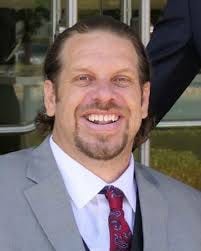On September 10th, 1994, my son Roman Reed received a spinal cord injury while playing college football. One moment he was having a superb game at middle linebacker, with eleven solo tackles and a diving one-hand interception; the next he collided with a 351 pound blocker and went down.
He has been paralyzed ever since. For 26 years he has endured the agonies of the damned, with no days off, never one moment when he is not paralyzed.
But he is still trying for new adventures, like running for Assembly.

Wherever possible, we have turned to science. When my daughter Desiree heard about an experimental medication (Sygen) going into clinical trials, I tried to get Roman in, but missed the deadline by one hour. I obtained the medication from Switzerland anyway, and went deep in debt to pay for the injections and six months of physical therapy. His mother Gloria had the house rebuilt (more debt) for adapted living.
Time passed and Roman and his wife Terri had three wonderful children, Roman Jr., Jason, and Katherine.
California named a law after him, the Roman Reed Spinal Cord Injury Research Act of 1999, which funded some of the world’s first stem cell paralysis research. Dr. Hans Keirstead made paralyzed rats walk again in the Roman Reed Lab at UC Irvine. Roman helped develop a similar law, the T.J. Atchison Spinal Cord Injury Research Act in Alabama.
Tom Okarma of Geron Inc., fought to take the research to clinical trials, before his company backed out of the stem cell effort for financial reasons.
Fortunately, Ed Wirth, Joe Gold, Jane Lebkowski and other scientists and entrepreneurs kept faith, so that Asterias Biotherapeutics (later Lineage Cell Therapeutics) continued, using OPC-1 the original stem cell line developed by Dr. Keirstead with funding from a Roman Reed grant.
But while these were strong steps forward, they paled in comparison with Proposition 71, the $3 billion California Stem Cell Research Proposition, begun and led by Bob Klein.
Officially titled the California Institute for Regenerative Medicine (CIRM) the stem cell program brought many forms of chronic illness and injury research forward, fighting for cure.
The clinical trials for paralysis have continued. The results?
No one was made worse, achieving the goal of safety; “First, do no harm”.
With safety established, greater quantities of cells were given to the next group of newly paralyzed volunteers. Improvements came, increased upper body strength and control. People like Jake Javier became visibly stronger and more active, returning to college.
But other problems emerged. The stem cell treatments were only for new injuries, the “acutes”, and that was not enough. Everyone wants the “chronic” injuries to be improved: people who have been paralyzed for more than just a few days. There was also the difficulty of the scar left by the injury, which formed a barrier to messages between brain and body.
How to get around the scar?
UCSD’s Mark Tuszynski hopes the concept of “relays” will answer that problem. Using a dye marker revealed his progress — x-rays show a flood of green leaping over the scar.
“Dr. T” used stem cells imbedded in gel, plus a nerve “fertilizer” — and gained chronic results. The rats that were tested in the study gained significant hand control (50% function) even after more than a year post-injury — a long time in spinal cord injury terms!
Dr. Tuszynski showed good success even with severe injuries, like rats with completely severed spines, which could move all four limbs. He was able to duplicate this with rhesus monkeys as well.
Dr. Eve Yi Sun is best known for her work fighting Rett Syndrome, a vicious disease which attacks young girls, afflicting them with lack of motor control.
She works at UCLA on a CIRM grant.
But she also commutes to the Beijing Advanced Innovation Center for Biomedical Engineering, at Beihang University in Beijing, China, where she fights paralysis.
She and Dr. Xiaoguang Li developed a way to remove the spinal cord injury scar, with an MRI device to “Guide the excision of scar tissue.” After that, a gel called NT3-chitosan (a nerve fertilizer, perhaps similar to Tuszynski’s) was placed in the wound., “to enable SCI repair and monitor regeneration, potentially in patients entering…the chronic phase.” — http://www.xinhuanet.com/English/2018–05/31/c_137220891.htm
CIRM has spent roughly $53 million ($52,626,285.00) dollars working toward the alleviation or cure of spinal cord injury paralysis.
By law, that money (with rare exceptions) must be spent in California. But international cooperation allows us to get more bang from the buck. So, we pay our scientists, they pay theirs, and both sides publish their work.
It is vital that the California stem cell program continue.
Proposition 14 would make that happen, by continuing the funding for CIRM.
If CIRM continues, I believe Christopher Reeve’s great prediction may come true.
The man millions thought of as “our Christopher” kindly dictated an introduction to my first book, “STEM CELL BATTLES”, saying:
“One day, Roman and I will stand up from our wheelchairs, and walk away from them forever.”
Cure did not come in time for the paralyzed Superman, but the flame of his faith still guides our way.

Christopher and Dana: gone but never to be forgotten
We will, as he always said, “Go forward!” — and we will prevail.
On November 3rd, vote YES! on Proposition 14: the California Stem Cell Research, Treatments and Cures Initiative of 2020.
Do it for someone who drives a wheelchair.
Don C. Reed is the author of “REVOLUTIONARY THERAPIES: How the California Stem Cell Program Saved Lives, Eased Suffering, and Changed the Face of Medicine Forever”, from World Scientific Publishing, Inc., 2020